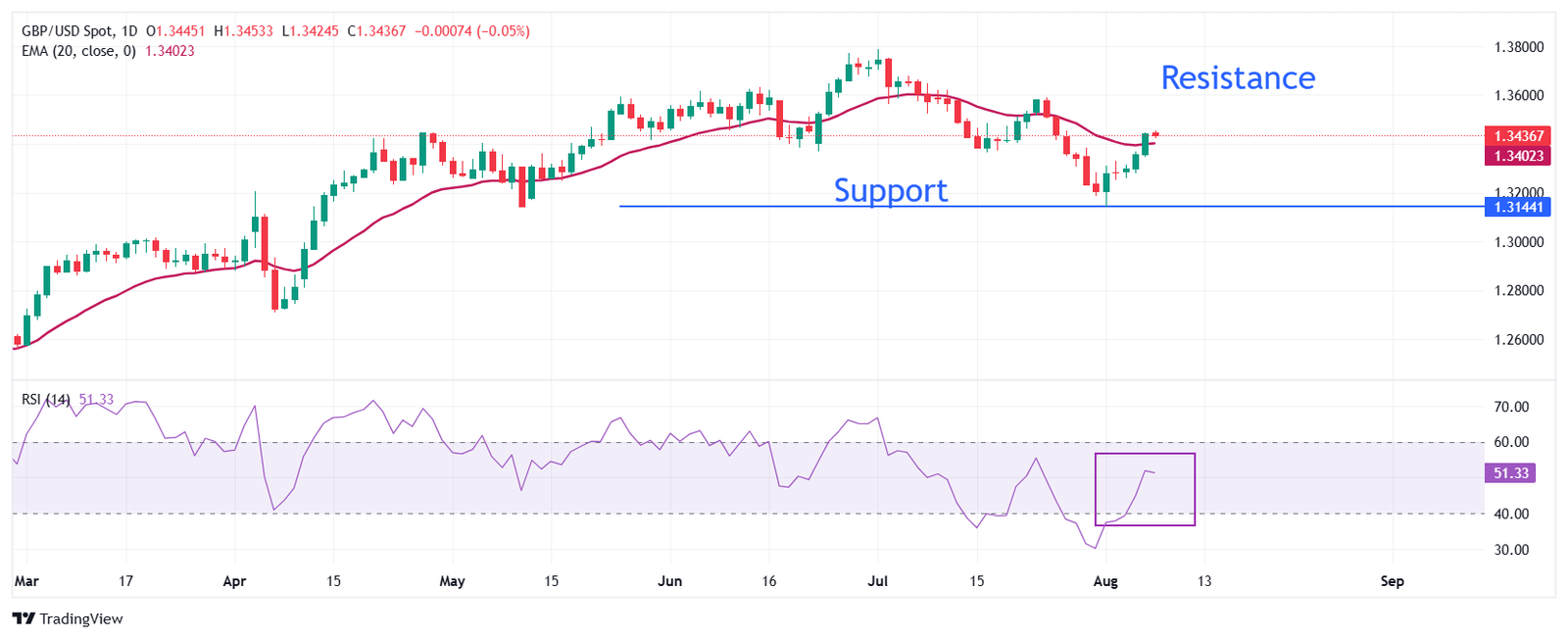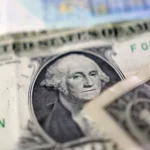- The Pound Sterling trades firmly against the US Dollar around 1.3450 as traders trim bets supporting BoE’s interest-rate cuts this year.
- Fed Governor Waller could be nominated as Chairman Powell’s successor.
- Investors await UK employment and US CPI data next week.
The Pound Sterling (GBP) clings to three-day gains around 1.3450 against the US Dollar (USD) on Friday. The GBP/USD pair trades firmly as upbeat expectations that the Federal Reserve (Fed) will cut interest rates in the September meeting have kept the US Dollar on the back foot.
According to the CME FedWatch tool, traders have almost fully priced a 25-basis point (bps) interest rate reduction by the Fed in September that would lower borrowing rates to 4.00%-4.25%.
Additionally, the nomination of Council of Economic Advisers Chairman Stephen Miran by US President Donald Trump for the replacement of Fed Governor Adriana Kugler would also increase support for interest rate cuts in the policy meeting next month. Market experts had anticipated that the entry of Trump’s candidate into the rate-setting committee will be favorable for his economic agenda. Trump has criticized the Fed, especially Chairman Jerome Powell, a number of times for supporting a restrictive monetary policy stance.
Meanwhile, a report from Bloomberg points that Fed Governor Christopher Waller could be Jerome Powell’s successor. The report also stated that Waller has met with Trump’s team members, who were impressed with him.
Pound Sterling trades firmly as BoE cuts interest rates with a slim majority
- The Pound Sterling holds onto Thursday’s gains during the European trading session on Friday as traders pare bets supporting interest rate cuts by the Bank of England (BoE) after the monetary policy announcement on Thursday, in which officials decided to cut rates but after a very tight vote.
- The data from money markets shows that traders see a 17 basis points (bps) interest rate reduction in the remainder of the year, suggesting that the BoE will hold interest rates at their current levels until 2026.
- On Thursday, the BoE reduced its key borrowing rates by 25 basis points (bps) to 4%, as expected, but the decision was taken by a very slim majority, something that markets hadn’t expected. Out of the nine members of the Monetary Policy Committee (MPC), five supported a rate cut, fewer than the seven anticipated by economists. Moreover, the initial vote split was an unprecedented 4-4-1, with four members favouring a hold and one opting for a 50 basis point cut. A second vote was needed to reach the final 5-4 majority to cut rates by 25 basis points, something never seen before.
- In the statement following the decision, the BoE maintained the wording of a “gradual and careful” approach to further easing of monetary policy.
- BoE Governor Andrew Bailey stated that the central bank is committed to bringing inflation sustainably to the 2% target. Bailey warned that rising food and energy prices are de-anchoring consumer inflation expectations, the labor market is softening and the growth outlook is subdued. The BoE raised one-year forward Consumer Price Index (CPI) projections to 2.7% from the 2.4% previously expected.
- Friday’s economic calendar is empty, except for Bank of England Chief Economist Huw Pill’s commentary in the National MPC Agency briefing at around 11:15 GMT. His words could be worth noting, considering the different perspectives on rates within the BoE as Pill voted to keep rates unchanged.
- Looking at next week, investors shift their focus to the United Kingdom (UK) labor market data for the three-months ending June, which is scheduled to be released on Tuesday.
- In the US, investors will closely monitor the US Consumer Price Index (CPI) data for July, which is scheduled to be released on Tuesday. Investors will pay close attention to the inflation data to confirm whether the impact of tariffs has started feeding into prices. June’s CPI report showed an increase in the price of goods that are largely imported into the economy.
- US headline inflation is expected to rise to 2.8% on year from June’s 2.7%. In the same period, the core CPI – which excludes volatile food and energy prices – is estimated to have risen by 3%, faster than the prior release of 2.9%.
Technical Analysis: Pound Sterling returns above 20-day EMA

The Pound Sterling clings to gains around 1.3450 against the US Dollar during European trading hours on Friday. The near-term trend of the pair has turned bullish as it has climbed back above the 20-day Exponential Moving Average (EMA), which trades around 1.3402.
The 14-day Relative Strength Index (RSI) bounces back above 50.00 after oscillating inside the 20.00-40.00 range in the past few trading sessions, suggesting an attempt for bullish reversal.
Looking down, the August 1 low of 1.3140 will act as a key support zone. On the upside, the July 23 high near 1.3585 will act as a key barrier.




















